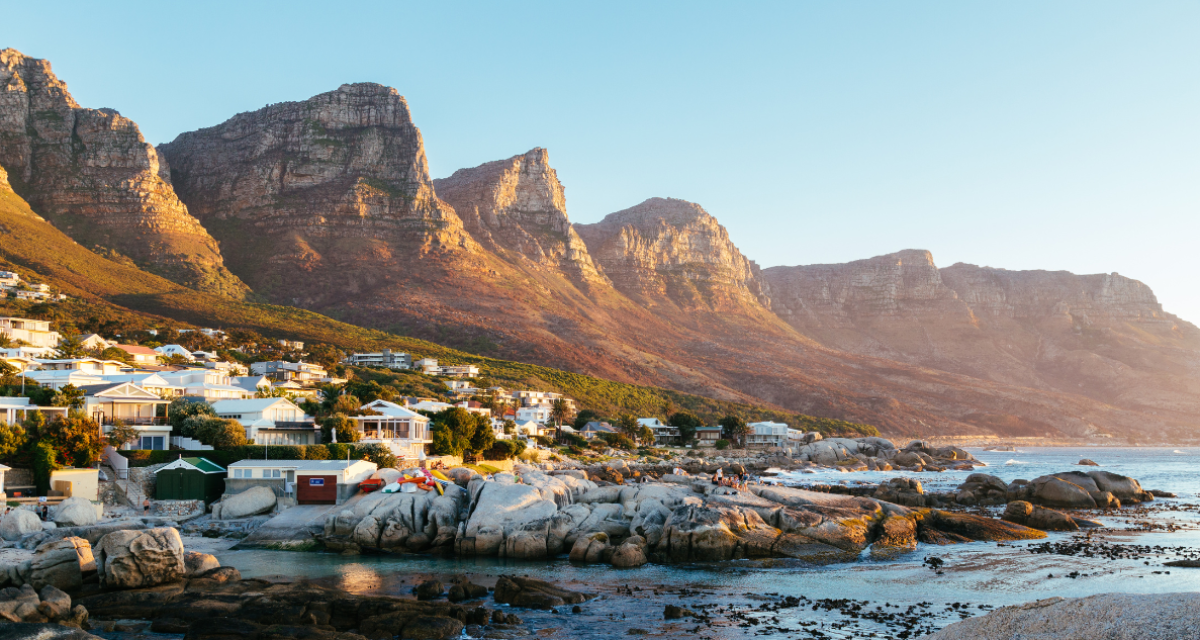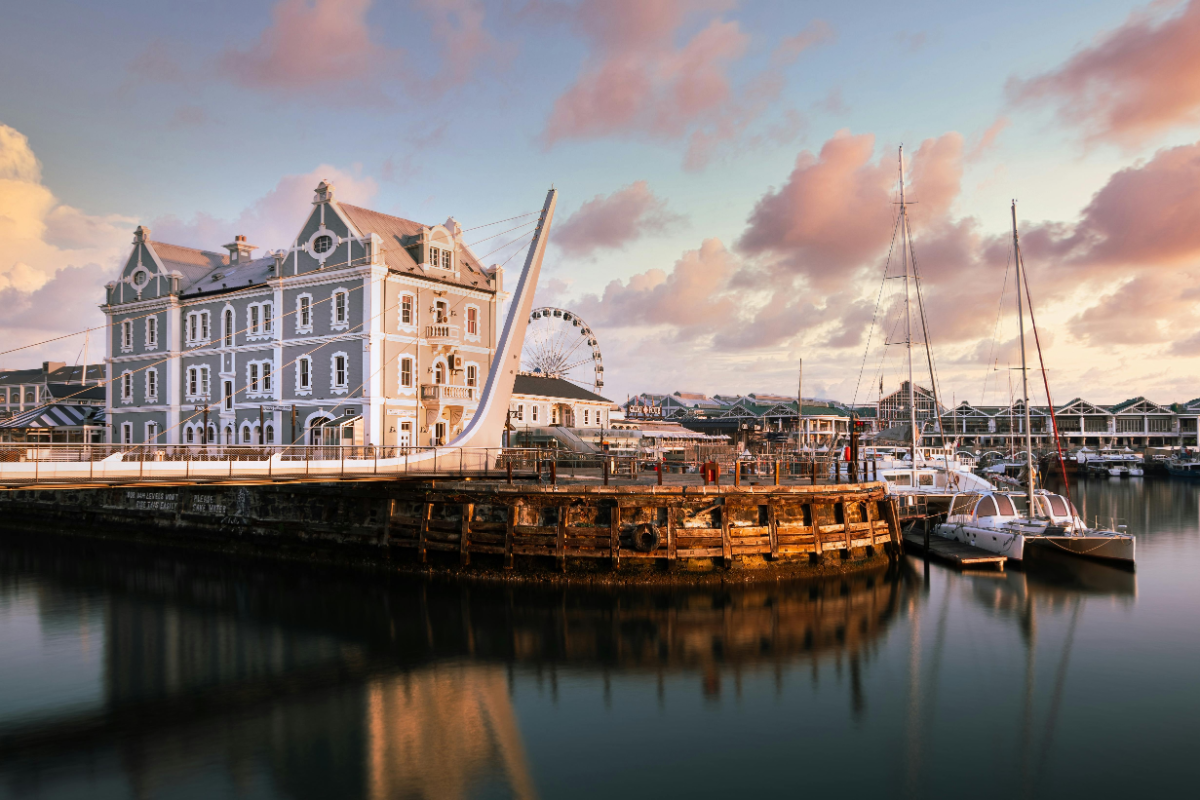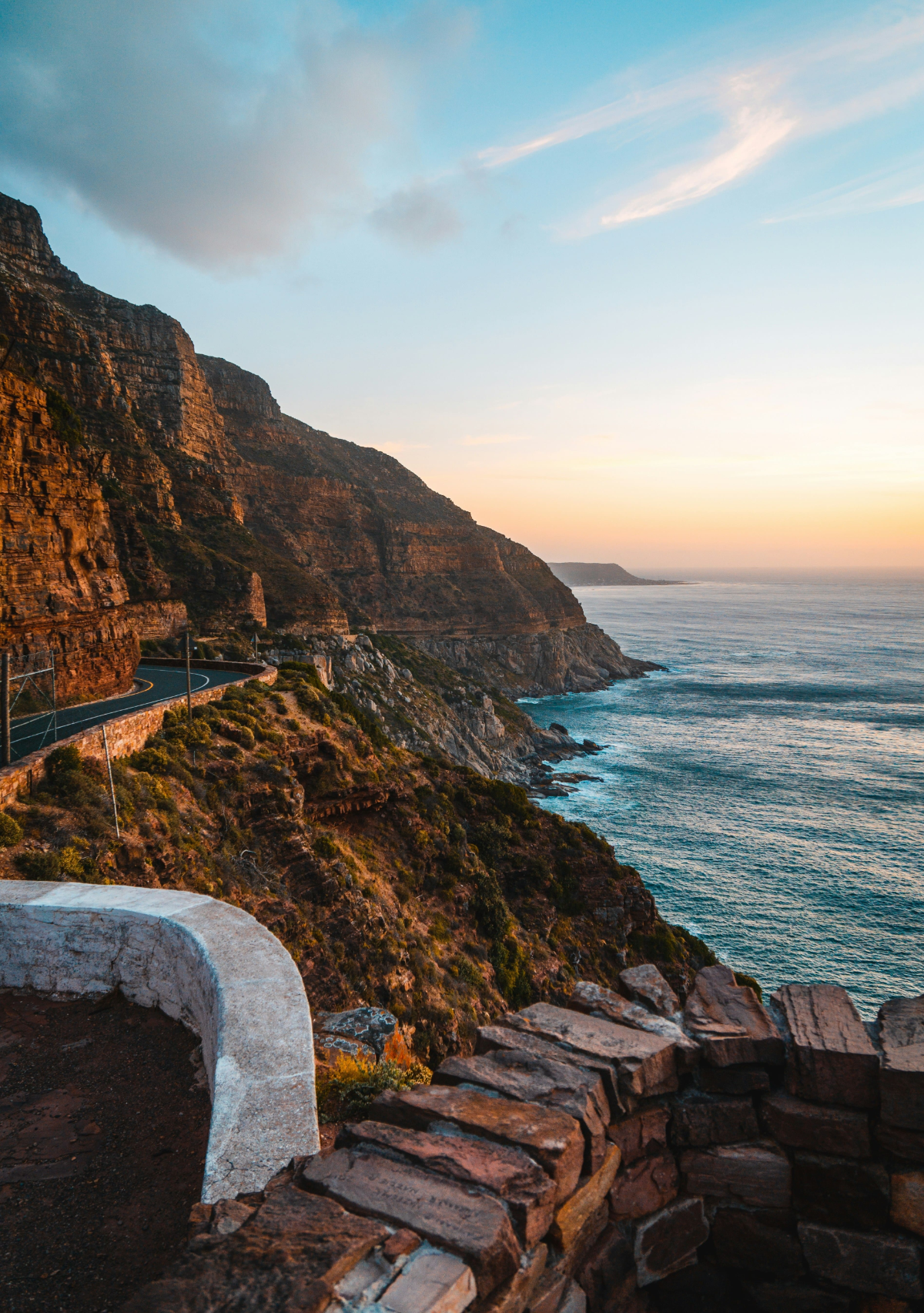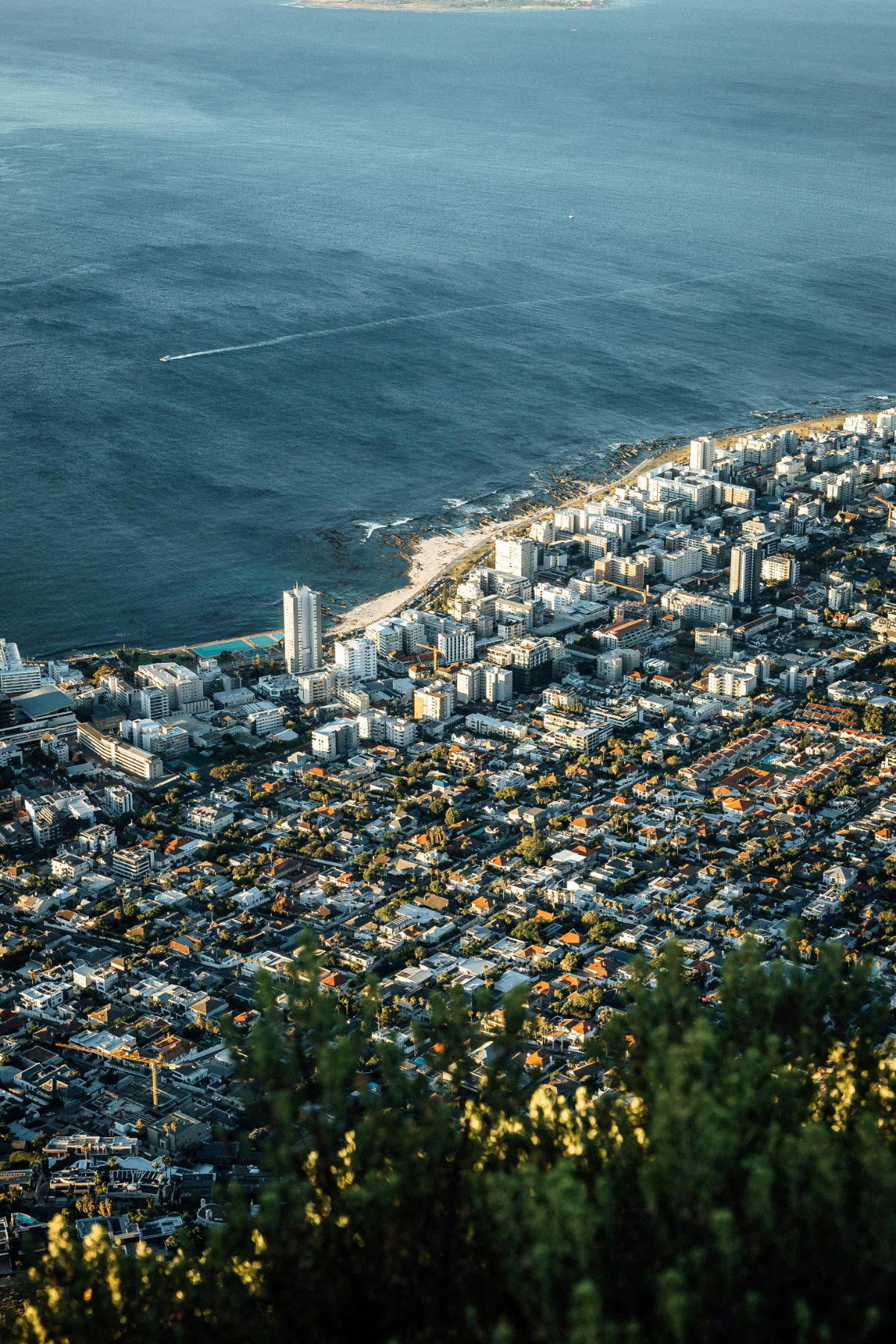The Ultimate Guide: What to Do In Cape Town
Last Update October 31, 2025
Plan your trip with this curated guide on what to do in Cape Town, South Africa, featuring coastal escapes, boutique stays, local food, and hidden gems.
Cape Town sits at the edge of the African continent in South Africa, the gateway to the diverse wonders of the Western Cape. With the iconic Table Mountain rising behind it and two oceans meeting at its feet, it’s a city grounded in contrast, wild and refined, familiar and unexpected. The region that surrounds it, from fynbos-covered mountain ranges to world-class wine valleys, deepens the experience, making Cape Town a portal into something broader, richer. There’s power in the way the city holds these opposites, and what to do in Cape Town becomes less about ticking off landmarks and more about feeling your way through them.
This is the Mother City, a place that moves at its own pace. One moment you're deep in conversation over local wine, the next you’re standing in silence atop a mountain. Whether you’re here for the natural wonders, the culture, or something you can’t quite name yet, Cape Town offers more than a list of things to do, it offers space to land.
Table of Contents
Affiliate Disclosure
Some links in this post are affiliate links. That means we may earn a small commission, at no additional cost to you, if you choose to make a purchase. These are always brands, stays, or experiences we would recommend to a dear friend. Thank you for supporting the quiet sustainability of Terra Selene.
Why Visit Cape Town
Cape Town is a place of convergence, where nature, culture, and history interlace. It’s one of the few cities in the world where you can hike a mountain in the morning, visit a vineyard by lunch, and close the day with your feet in the sea. With its layered heritage, vibrant food scene, and design-forward stays, the city offers every kind of traveler a place to anchor. Whether you're drawn to adventure, creativity, or quiet immersion, Cape Town gives more than it asks.
Best Time to Visit CAPE TOWN
Cape Town isn’t defined by one perfect travel season; each time of year reveals a different facet of the city. From sunlit summers on the coast to crisp autumns in the vineyards, every season invites a unique way to experience its landscape, rhythm, and culture. Below, a seasonal breakdown to help you decide the best time to visit Cape Town based on your pace, preferences, and what you’re hoping to feel.
Summer (December to March)
Best for: First-time visitors · Beach holidays · Outdoor dining · Social energy
Summer is Cape Town in full bloom. These are the city’s hottest months, with long daylight hours, minimal rainfall, and an undeniable vibrancy. Think ocean swims at Clifton, market lunches in the shade of Table Mountain, golden hour drives along Chapman’s Peak. Rooftop bars fill with local DJs and sundowners, while the city’s festivals and open-air events reach their peak.
Expect hot, dry days (25–35°C), bustling beaches, and a distinctly social rhythm. December through early January is the busiest time of year, so book well in advance. The crowds bring energy, but also higher prices and limited availability.
If you love movement, sunlight, and a sense of celebratory momentum, this is your season.
Autumn (April to May)
Best for: Wine lovers · Fewer crowds · Golden light · Slower travel
Autumn is where the city exhales. Temperatures cool, harvest season begins in the Cape Winelands, and locals reclaim their routines. Vineyards in Stellenbosch and Constantia turn amber and ochre, offering long, unhurried tastings and misty morning walks through the vines.
Daytime weather is still warm (18–25°C), with crisp evenings perfect for fireside dining. Hikes become more manageable as the heat recedes, and cultural venues feel less crowded. It’s a season for slow mornings, for falling into rhythm with the land, for long-table lunches under fig trees and open sky.
Travelers who visit during autumn often find a more authentic, less hurried Cape Town, one that invites you to linger.
Winter (June to August)
Best for: Whale watching · Cozy interiors · Cultural exploration · Off-season calm
Winter in Cape Town is moody and poetic. The rains arrive, but so does an intimacy, in the quiet museums, the scent of woodsmoke in mountain air, the slow-simmering stews shared around heavy wooden tables.
This is whale season: southern right whales migrate along the coast from June through November, with Hermanus and False Bay offering front-row seats. Accommodations are more affordable, and the off-season calm appeals to travelers who don’t mind packing layers in exchange for deeper stillness.
You’ll find cozy guesthouses with fireplaces, spa retreats in the Winelands, and an invitation to lean into the indoors, galleries, wine cellars, and performance spaces. And when the clouds part? Table Mountain glows in winter light like nowhere else.
Spring (September to November)
Best for: Nature lovers · Botanical experiences · Shoulder season savings · Surfing
Spring is Cape Town’s soft awakening, a moment that often slips under the radar, but is perhaps the most balanced time to visit. Temperatures rise gently (17–27°C), wildflowers bloom across the West Coast, and the city regains its energy without the pressure of high season.
The fynbos biome comes alive, making it a spectacular time for hikes, garden visits (like Kirstenbosch), and walks along the coast. Surfers return to the water, and local markets buzz again with the first stone fruits, fresh breads, and woven crafts.
This is also a perfect shoulder season for travel deals and lower accommodation rates. The days are bright, but the evenings still call for layers. If you're looking for a time when Cape Town is in motion but not in haste, this is your season.
Planning Your Trip to cape town
Planning a journey to Cape Town is about more than logistics, it’s about setting the tone for how you want to arrive. This bustling city, known as the Mother City of South Africa, holds a unique tempo: layered, sensory, and quietly expansive. Whether you’re drawn to its top attractions, beautiful beaches, or a slower encounter with land and culture, it rewards both structure and spontaneity.
Itinerary Tips
How you navigate Cape Town defines what it gives back. While a curated list of must-sees can anchor your visit, the real alchemy lies in the unexpected. Let rhythm guide you. A Cape Town City Pass streamlines entry to major landmarks, from museums and botanical gardens to historical sites, offering savings in both time and budget.
To avoid burnout, resist the urge to over-schedule. Choose one anchor activity each day, whether a sunrise hike, a vineyard lunch, or a cultural immersion, and leave room for intuitive detours. The city rewards flexibility. A spontaneous walk along the Sea Point Promenade or a last-minute market stop often becomes the memory that lingers.
Pack for unpredictability. Cape Town’s microclimates mean it can be misty in the mountains while the beaches are sun-soaked. Bring versatile clothing: breathable layers, a windbreaker, a swimsuit, and durable walking shoes. Keep a light scarf or shawl handy, for sun, breeze, or an impromptu picnic.
If you’re venturing beyond the urban core, rent a car for ease and access, particularly if visiting the peninsula, the Winelands, or hidden beaches along the Atlantic coast. For those staying central, walking and Uber are reliable. Consider joining a local-led walking tour to uncover the context behind the facades.
Capitalize on early mornings and golden hours. Start your day early to beat crowds at major sites like Table Mountain or Kirstenbosch. Late afternoon light transforms coastal drives and vineyards into cinematic experiences.
Build in downtime. Not every hour needs a destination. Let the city breathe through you, with coffee at a corner café, a gallery you stumble upon, a stretch of sand shared only with the horizon, or a private game drive just beyond the city where stillness arrives not from silence, but from the wild.
A Note on Safety
Cape Town, like the country it anchors, is layered, alive, and asks you to arrive with presence. It offers travelers extraordinary richness, but asks for discernment in return. Solo travel here is possible, even nourishing, when met with grounded awareness and clear boundaries.
Move intuitively. Avoid walking alone at night, and during the day, follow well-trafficked, familiar routes. Don’t carry more than you need, and keep essentials, like your phone, cards, and keys, close to the body, ideally in a zipped crossbody or under-clothing pouch. Let your confidence speak quietly through awareness, not assumption.
Avoid public minibus taxis entirely; they are not designed for visitors. Instead, use Uber, or have your hotel arrange a vetted private driver. Always confirm license plates and driver names before getting in. If you rent a car, lock doors at all times, keep belongings out of sight, and never leave anything visible on the seat, not even a jacket. Drive with your windows rolled up, especially at stops.
Accommodations, even luxury ones, benefit from simple safeguards: double-lock doors, use in-room safes, and avoid letting anyone in unless expected. Store backup copies of important documents separately from the originals, and consider a decoy wallet with a small amount of local currency.
It’s worth having travel insurance that extends beyond the basics, covering everything from theft to medical emergencies. Save a hard copy of emergency numbers, and stay registered with your embassy or consulate if applicable.
In Cape Town, safety isn’t about shrinking; it’s about soft boundaries that create space for deeper exploration. Awareness allows you to settle in. To connect. To walk the coastline at golden hour with quiet confidence. Let caution be your compass, not your cage.
Getting to Cape Town
Cape Town, often called the gateway to the Western Cape, is well-connected and remarkably accessible. The Cape Town International Airport, just 20 kilometers from the city center, is the region’s primary entry point, with direct flights arriving from Africa, Europe, Asia, and the Americas. Whether you’re arriving internationally or domestically, the experience is efficient and intuitive.
Most travelers opt to rent a car directly from the airport, especially those planning to explore beyond the city, from the Cape Peninsula to the Winelands. If you're heading straight into the city center, Uber is the most reliable rideshare option and is widely used. Alternatively, many boutique hotels and guesthouses offer vetted airport transfers, which can be pre-arranged for added peace of mind.
If you’re already in South Africa, driving into Cape Town is a scenic option. Routes from Johannesburg, Durban, or the Garden Route are well-maintained and thread through a diverse landscape of vineyard valleys, coastal cliffs, and mountain passes. Road-tripping allows for slow travel and spontaneous exploration, the kind of journey where the in-between becomes just as memorable as the destination.
Once in Cape Town, having your own vehicle gives you the flexibility to discover the outer regions on your own time. For those who prefer to stay centered, Uber and guided day tours are accessible and reliable. However you choose to arrive, getting to and around Cape Town becomes part of the story you carry home.
Getting Around the City
Getting around Cape Town is a breeze, thanks to its well-developed public transportation system and various other convenient options. Whether you prefer the ease of public transit or the freedom of exploring on your own, Cape Town has something to suit every traveler’s needs.
The MyCiti bus system is a convenient and affordable way to navigate the city. With routes covering many of Cape Town’s top attractions, it’s an excellent option for getting around. The buses are modern, reliable, and offer a great way to see the city without the hassle of driving.
For shorter trips, taxis and Uber are readily available and provide a more flexible option. An Uber ride is particularly convenient for reaching local attractions like beaches and restaurants, especially at night. While they may be more expensive than public transportation, they offer the convenience of door-to-door service while ensuring you arrive safely.
If you’re planning to explore beyond the city center, renting a car is a fantastic option. It gives you the freedom to create your own itinerary and discover the surrounding areas at your own pace. Cape Town’s scenic coastal roads, like the iconic Chapman’s Peak Drive, offer stunning views of the Atlantic Ocean and are a must-do for any visitor.
Cape Town is a relatively small city, and many of its top attractions are within walking distance of each other. The city is also becoming increasingly bike-friendly, with dedicated bike lanes and pedestrianized streets. Consider taking a bike tour or renting a scooter to explore the city and its surroundings. Just remember to wear a helmet and follow traffic rules for a safe and enjoyable ride.
With its stunning natural beauty and vibrant culture, Cape Town is a city that’s easy to get around and explore, whether you’re on foot, by bike, or in a car. Embrace the adventure and discover all that this incredible city has to offer.
Where to Stay: Neighborhoods with Intention
Cape Town’s neighborhoods are portals into different rhythms of the city. Choosing where to stay means choosing how you’ll encounter the city each day. Here are curated areas, all within 10 to 25 minutes of Table Mountain, to help ground your decision:
Oranjezicht and Tamboerskloof: Nestled on the slopes just beneath Table Mountain, these neighborhoods offer slow luxury with panoramic views and direct trail access. You’re close enough to the city center for easy day trips, yet removed enough to hear birdsong at sunrise. Ideal for travelers who want immersion without the buzz.
Bantry Bay: Tucked just around Lion’s Head from the more frenetic Seaboard, Bantry Bay is wind-sheltered and elegant. You’ll find calm seas, sophisticated homes, and proximity to both Clifton’s beaches and Sea Point’s promenade. It’s serenity with access.
Clifton and Bakoven: Located along the Atlantic Seaboard, just below Table Mountain’s southwestern flank, these beachside enclaves offer immediate access to white-sand coves and golden sunsets. Clifton is polished and photogenic; Bakoven is more understated, residential, and soulful.
Constantia: South of Table Mountain, set within Cape Town’s oldest wine-producing region, Constantia is lush, tree-lined, and quietly opulent. Here, heritage estates and mountain views pair with wine tastings and tranquil garden walks. Ideal for travelers seeking a retreat within reach, just 25 minutes from the city center.
Each area offers not only proximity to landmarks but also a distinct emotional tone. Choose based on how you want Cape Town to feel, residential or buzzing, elevated or oceanic, grounded or green.
Handpicked boutique Hotels
Labotessa – Hidden in plain sight on Church Square, Labotessa is more than a hotel; it’s a moment of quiet elegance in the heart of the city. With just six suites, it offers intimacy without austerity, blending European heritage with modern refinement. Expect French oak floors, curated art, and brass-accented interiors that glow in the afternoon light. Mornings begin with in-suite espresso and cathedral views; evenings unfold with aperitifs on velvet chairs, city murmurs below. This is a space that doesn’t rush to impress; it lingers and asks you to do the same.
Gorgeous George - Bold but not brash, Gorgeous George is Cape Town’s creative pulse personified. Set between heritage façades and industrial textures, its interiors layer contemporary African art with raw concrete, brass piping, and unapologetic flair. The rooftop, part cocktail bar, part plunge pool, part local hangout, hums with designer nonchalance and skyline views. It’s where you go not just to sleep, but to feel the city’s rhythm from the inside out. Every floor reveals a story, every corner curated. For travelers drawn to edge, color, and unexpected conversations, this is your address.
The NOAH - Perched quietly in Tamboerskloof beneath the curve of Lion’s Head, The NOAH offers a grounded, design-forward retreat just minutes from Cape Town’s urban heartbeat. With raw textures, clean lines, and a neutral palette that mirrors the mountain it faces, this boutique stay balances modern architecture with soulful restraint. It’s the kind of place where the air feels slower, the light falls softer, and the city feels just close enough.
Future Found Sanctuary – Set against the forested slopes of Table Mountain in Hout Bay, Future Found Sanctuary isn’t just a stay, it’s a recalibration. This architecturally fluid property folds into the landscape rather than imposing on it, offering a collection of villas designed for rest, ritual, and reconnection. Every detail, from the biodiverse gardens and daily movement classes to curated sensory therapies and seasonal menus, is an invitation to return to the body, to the moment, to nature. This is not a hotel. It’s a sanctuary for the nervous system. A place for those who travel not to escape, but to deepen.
Where you stay in Cape Town shapes your entire experience. Choose with intention.
Cape Town's Food and Wine
Cape Town's culinary landscape unfolds quietly, shaped by season, memory, and intention. Rooted in migration, ritual, and reinvention, the city’s food scene is an invitation to listen: to the land, to the history on the plate, to the textures of a place shaped by convergence.
Cape Town's most compelling restaurants aren’t simply places to eat, they’re spaces that hold intention:
FYN – Minimalist and moody, this tasting experience blends Japanese technique with African ingredients. Each course lands with precision, holding a quiet narrative of land and lineage.
Beyond – Nestled in Constantia’s vineyard cradle, Beyond presents terroir through restraint. Every dish is anchored to source, elemental, assured.
The Test Kitchen Fledgelings – A socially-driven offshoot of the original, this space nurtures emerging talent without losing clarity or craft. It pulses with memory and promise.
The Pot Luck Club – Industrial edges, rooftop altitude, and bold, unexpected plates. A place to tune into rhythm, salted, smoked, and stirred.
Reverie Social Table – One table, one changing menu. Intimate, atmospheric, and quietly magnetic. Stories served alongside supper.
On weekends, Cape Town gathers around its markets, communal, seasonal, and sensory. The Oranjezicht City Farm Market, perched beneath Table Mountain, layers organic produce, artisanal goods, and street food into a ritual of its own. Come early, linger long. In Hout Bay, a coastal warehouse hums with live music, ocean air, and steaming bowls across cultures. The Biscuit Mill in Woodstock spills with design, food, and shared momentum.
To venture into the Cape Winelands is to step into a sensory threshold, where light stretches longer, time folds inward, and flavor speaks in slow tones. Just 30–45 minutes from the city, the landscape shifts: vineyard-draped hills, gabled farmhouses, gravel paths underfoot. Babylonstoren, Waterkloof, Thelema, Beau Constantia, each estate a living dialogue between architecture and agriculture, design and devotion. For a deeper exploration and in-depth guide of the most intentional estates, slow-season timing, and how to taste with presence, wander Beyond The City.
Stellenbosch holds particular gravity. As one of the oldest wine-producing regions in the southern hemisphere, it offers more than its varietals; it offers legacy. Oak trees frame streets of heritage facades, and cellars echo with stories spanning centuries. Here, tasting is not rushed. You’re invited to sit longer. To sense more. Pairings lean local, fynbos honeys, soft cheeses, wild mushrooms, pressed oils.
In the Cape, nourishment extends beyond the plate. It’s felt in how the table is laid, how the land is held, how long you’re invited to stay. This is about presence. Meals become memory. Wines carry place. And everything tastes, somehow, of the pause that allowed you to notice.
Outdoor Experiences
Cape Town's landscape offers a view that invites movement, attention, and intimacy with place. The outdoors here isn’t a backdrop; it is texture, tempo, and presence. Whether moving across its peaks, tracing the contours of its shoreline, or walking through flora found nowhere else on earth, each path invites participation rather than observation.
The Cape’s environment reveals itself slowly, through repetition, the rustle of fynbos underfoot in the Table Mountain National Park, the scent of salt on Boulders Beach, the play of clouds across breathtaking landscapes. These natural rhythms stay with you. This is scenery that holds a relationship, layered, living, and responsive. The land holds presence; it engages, responds, and remembers.
From elevated trails to ocean edges, every step reorients. Time feels shaped by terrain. And long after you leave, the land keeps speaking.
MOUNTAIN TRAILS
Start with the mountains. Table Mountain rises quietly yet unmistakably above Cape Town, an anchor in both geography and spirit. Multiple hiking trails lead upward, each shaped by its own tempo and terrain. For gentle immersion, the contour paths offer layered views and a steady rhythm. Those seeking vertical challenge can take the India Venster route, a technical ascent that calls for confidence and care. Many choose to hike up and descend by cable car, allowing effort and ease to coexist in the same journey. Lion’s Head, spiraling above the Atlantic, offers a separate kind of movement, local, communal, and luminous at full moon. In these elevations, perspective expands with every step.
Forest sanctuaries and botanical Gardens
Beneath the mountain’s shadow, Cape Town’s forested spaces offer a kind of shelter that’s rare, cool, canopied, and deeply restorative.
Newlands Forest, nestled on the eastern slopes of Table Mountain, is one of the city’s most beloved refuges. Locals come here for shaded trails, soft pine needle paths, and the quiet companionship of moss-covered trees and flowing streams. It’s a place where the city falls away almost immediately, replaced by birdsong, bark textures, and the earthy rhythm of breath and footfall. Whether you’re walking, trail running, or finding a quiet moment on a bench, Newlands offers reprieve without spectacle.
Higher up the slope, Kirstenbosch National Botanical Garden unfolds like a living archive of South Africa’s botanical wealth. Set within the Cape Floral Kingdom, the smallest and most diverse of the world’s six plant kingdoms, Kirstenbosch is home to over 7,000 species, most of them endemic. This is not a manicured park, but a curated wild, where proteas bloom beside stone pathways and cycads trace ancient lineages under open sky.
One of its most distinctive features is the Boomslang Canopy Walkway, an elevated, serpentine path that curves above the treetops. From here, the view stretches across the gardens, into the forest, and back toward Table Mountain’s ridgeline. It’s an ideal vantage point at golden hour, when shadows lengthen and the garden begins to exhale.
Seasonal events bring even more life to the space, from open-air concerts to sculpture exhibitions nestled among the foliage. But even without an event, Kirstenbosch is an invitation to wander. To study leaf texture. To move slowly. To lie on the grass and trace cloud shapes through camphor-scented air.
These green spaces hold a different energy from the coastline, quieter, denser, more inward. They remind you that wildness isn’t always loud, and that sanctuary often begins with simply being surrounded.
Ocean Activities
Move toward the coastline, and Cape Town begins to shift, sea-salted, untamed, and rhythmic. Simon’s Town, along the coastal road to Cape Point, offers sheltered beaches and a close encounter with the resident African penguins at Boulders Beach, a colony folded into granite boulders and tidal hush. Rent a kayak from the V&A Waterfront or Hout Bay and glide across kelp-lined waters, where seals lounge and dolphins often trace your wake. For something slower, paddleboard the calm coves of Clifton or join a sunrise plunge in Bantry Bay, a quiet, collective ritual that marks the day before it begins.
For marine encounters on land, the Two Oceans Aquarium at the Waterfront provides an immersive look into the biodiversity of South Africa’s surrounding seas, from kelp forests to coral coastlines. Though the Atlantic and Indian Oceans officially meet at Cape Agulhas, the aquarium captures the ecological dialogue between them, offering hands-on exhibits for all ages.
Tidal Pools and coastal walks
Cape Town’s tidal pools offer a kind of intimacy that’s rare, protected, uncommercial, and shaped by the sea itself. Carved into the rock along the Atlantic and False Bay coastlines, each pool carries its own microclimate and character. Saunders Rock, tucked beneath the cliffs of Bantry Bay, is a favored morning ritual for locals seeking calm waters and early light. On the other side of the peninsula, St James and Dalebrook are better suited to families and slower swimmers, the water warmer, the rhythm softer, the energy communal.
These pools aren’t tourist spots. They’re part of Cape Town’s living memory, spaces that hold generations, quiet rituals, and the city’s elemental rhythm. To swim here isn’t about distance or speed. It’s about belonging to the water, even briefly.
Coastal Walks and Scenic Routes
Cape Town’s coastline isn’t only to be admired, it’s meant to be walked. From urban promenades to wild bluffside trails, the city invites you to move in tandem with the sea.
The Sea Point Promenade is the most accessible of these, a paved walkway stretching from Mouille Point to Bakoven. Here, locals walk dogs, parents push strollers, and visitors pause often, to watch the waves, the paragliders overhead, or the silhouettes that gather for sunset. It’s the city’s daily exhale, and it links much of the Atlantic Seaboard with ease.
Further south, hiking trails at Cape Point wind through fynbos-covered cliffs, offering sweeping ocean views and fragrant air. These routes form part of the Cape Floral Region Protected Areas, a UNESCO World Heritage Site rich in endemic biodiversity. Each step through this landscape is immersive: salt on the skin, wind at your back, the scent of wild herbs underfoot.
For a change in tempo, Noordhoek Beach offers a long stretch of untouched coastline, ideal for horseback rides, barefoot walking, or quiet contemplation. Its scale softens you, widening both horizon and breath.
Beaches and Coastline
Cape Town’s beaches are more than destinations; they are moods, mirrored in sand and swell. From sculpted, wave-kissed coves to wide, palm-lined stretches, each one offers a distinct expression of the coast’s layered beauty.
Clifton Beach, divided into four small coves, is defined by smooth granite boulders, soft white sand, and striking blue water. Fourth Beach draws swimmers, sunbathers, and paddleboarders. Some come for the solitude, others for the scene, all are met with that unmistakable Atlantic cool.
Camps Bay sits just around the bend, framed by palm trees, cafés, and the slow procession of sundowners settling into terrace seats. The beach itself is broad and bright, perfect for swimming, volleyball, or simply lying low.
Further along the False Bay coast, Boulders Beach offers a quieter encounter, a sheltered bay shared with a resident colony of African penguins. It’s one of the few places in the world where you can swim alongside these wild birds, their calls echoing between the granite outcrops. The water here is warmer, and the mood softer, ideal for families and low-tide wading.
Cape Town’s coastline also offers some of the best water sports conditions in the country. Surfing, paddleboarding, and kayaking are accessible across multiple beaches, with local rental shops and instructors available for every level. Many beaches, including Camps Bay, Clifton, and Muizenberg, are patrolled by lifeguards, ensuring safety while you explore.
Whether you’re swimming, strolling, or simply sinking into the texture of the day, Cape Town’s coastline invites both movement and stillness, a space where elemental beauty and lived ritual meet.
Art and Creative Encounters
Cape Town’s creativity reveals itself in subtle layers, woven through its streets, gardens, galleries, and natural spaces. Rather than approaching culture through historical pain, you can engage with its expressive, future-facing spirit through art, design, and immersive outdoor spaces.
Start with the Dylan Lewis Sculpture Garden in Stellenbosch, a contemplative blend of monumental bronze forms and indigenous flora, shaped as much by silence as by stone. Set across rolling hills and curated wildness, the space holds more than 60 works that explore the primal tensions between wilderness and civilization, instinct and consciousness. Rooted in Jungian philosophy, the garden becomes a symbolic journey through the psyche, each sculpture a threshold, inviting reflection on the wild within and the shape it takes in stillness.
Back in the city, creativity unfurls more quietly. In Sea Point, the Green Point Urban Park offers a gentler rhythm, winding pathways through indigenous gardens, shaded benches beside lotus ponds, and sculptural installations that mirror the surrounding landscape. It's a serene counterpoint to the city’s energy, one that feels intentional, cared for, and human-scaled.
For curated art encounters, explore Cape Town’s growing gallery scene. First Thursdays, held on the first Thursday of every month, transform select neighborhoods into an open-air gallery crawl, with Kloof Street, Loop Street, and De Waterkant offering access to contemporary exhibitions, book launches, and design pop-ups. These evenings invite connection, to artist and audience, to city and spirit, in a way that feels organic and elevated. Expect everything from minimalist sculpture and moody abstracts to conceptual installations tucked behind understated storefronts.
In the quieter hours, spaces like the Everard Read Gallery, SMAC Gallery, or Whatiftheworld present thoughtfully curated shows that lean toward emotional and conceptual resonance. And for those seeking performance, the Baxter Theatre offers live productions that blend heritage with innovation, while the Norval Foundation, just outside the city, combines sculpture gardens with a rotating collection of contemporary African art, ideal for a slower afternoon that lingers long after.
Here, art isn’t entertainment. It’s a dialogue. An offering. A way to witness, and be witnessed.
Nature and Wildlife
Cape Town draws its character from the land itself. The wild here isn’t ornamental; it’s integral. It hums beneath your feet, curls around the coastline, and climbs skyward through sandstone and mist.
Table Mountain, the city’s stone spine, offers more than just a view. To ascend it, whether by trail or cable car, is to step into a space where perspective shifts. The India Venster route traces the folds of the mountain with exposed edges and unexpected stillness, while Platteklip Gorge, steep and direct, offers a pilgrimage through shadow and grit. At the summit, what unfolds is not just scenery, but a stilling, a vastness that rearranges your sense of scale.
Further south, the Cape of Good Hope stretches into myth, its cliffs wind-scoured, its fynbos terrain perfumed with resilience. This is where two oceans meet in ritual, where baboons trace ancient paths and the wind speaks first. It's not just a point on a map, it’s a reminder that some places remain untamed on purpose.
Kirstenbosch National Botanical Garden, nestled at the foot of Table Mountain, is a haven for plant enthusiasts. This world-renowned garden showcases the rich biodiversity of the Cape Floral Kingdom, with a vast collection of indigenous plants. The Boomslang canopy walkway offers a unique perspective, allowing you to walk among the treetops and enjoy stunning views of the garden and the mountain.
Cape Town’s proximity to nature reserves and wildlife areas makes it an ideal destination for outdoor enthusiasts. For those craving a slower rhythm, our eco cabin round-up maps out off-grid stays where design meets seclusion, from solar-powered pods to forest-edge hot tubs. The Cape of Good Hope, part of Table Mountain National Park, is home to a variety of wildlife, including baboons, ostriches, and antelope. The dramatic cliffs and rugged coastline provide a stunning setting for hiking and wildlife spotting.
At Boulders Beach, the presence of penguins feels both intimate and surreal. They move through tide-washed corridors of granite, between driftwood and sun-warmed stone, indifferent to the quiet awe they leave behind. The water here is unusually calm for this coastline, a series of natural inlets that cradle you rather than test you. Swimming becomes something else entirely: not exercise, not spectacle, just immersion.
Those drawn to the sea in its wider forms will find deeper encounters offshore. Boat journeys from Hout Bay or the V&A Waterfront bring you into the realm of whales, dolphins, and seal colonies, not behind glass or on cue, but as they are, in motion and in silence. You feel the scale of it, the distance between yourself and something far older. These moments aren’t manufactured; they arrive unexpectedly and leave something behind.
Inland, the terrain shifts again. The Cape Winelands open like a slow exhale, vineyards stretching toward the base of sandstone mountains, heritage estates marked by whitewashed gables and timeworn stone. While the region is vast, something is grounding about its proximity. Within half an hour of the city, you’re seated under oak trees, sipping from a stemmed glass as if nothing beyond that moment exists. Constantia, Cape Town’s oldest wine region, holds this energy especially well, not grandiose, but generous. The kind of place where you lose track of time between courses, where the land is present in the wine, and the quiet between conversations feels just as full.
Cape Town doesn’t just offer access to nature; it draws you into an entirely different pace of being. One where movement slows, and awareness sharpens. Where your attention lands more fully on the shape of the land, the scent of wild herbs in the air, the way the light falls unevenly on old walls. Whether you’re tracing a path through coastal fynbos, listening for whales beyond the surf line, or pouring another glass with no thought of what comes next, these aren’t just activities. They’re invitations. Ways in. Ways back to yourself.
Day Trips from Cape Town
Cape Town is a fantastic base for exploring the surrounding region. With a variety of day trip options available, you can experience the diverse beauty and culture of South Africa without straying too far from the city.
One of the most popular day trips is to the Cape of Good Hope. This iconic landmark offers breathtaking views of the Atlantic Ocean and the chance to see African penguins and other wildlife in their natural habitat. The dramatic cliffs and scenic landscapes make it a must-visit for nature lovers and photographers alike. For couples, there are plenty of romantic things to do, such as watching a sunset at Lagoon Beach with a stunning view of Table Mountain.
For those who love the beach, a visit to the beautiful beaches and towns along the Atlantic Coast is a must. Camps Bay and Clifton are renowned for their soft sand, clear waters, and vibrant beach culture. Spend the day soaking up the sun, swimming in the ocean, or enjoying a meal at one of the beachfront restaurants.
Wine enthusiasts will find the Cape Winelands to be a delightful day trip. Just a short drive from Cape Town, this region offers stunning scenery and the opportunity to taste some of South Africa’s finest wines. Visit renowned estates like Babylonstoren, Waterkloof, and Beau Constantia, each offering a unique experience of terroir, design, and hospitality. To extend your experience beyond quick tastings, review our Cape Winelands Guide which traces conscious winemaking, seasonal rhythms, mindfully exploring Stellenbosch, Franschhoek, Constantia and beyond.
The Garden Route, known for its stunning natural scenery and outdoor activities, is another excellent option for a day trip. Whether you’re interested in hiking, surfing, or simply enjoying the picturesque landscapes, the Garden Route has something for everyone.
To move with ease through this region, begin with intention. Research and booking in advance allows for a more spacious experience, one that aligns with your pace rather than rushing it. Many trusted guides and local operators offer curated day trips from Cape Town, opening thoughtful access to the surrounding landscapes.
what lingers after cape town
Cape Town imprints itself gently, yet indelibly. You’ll find it later, in the salt along your collar, the citrus tang of a shared sundowner, the hush of fynbos after wind. It’s not a city that performs; it reveals. One meal, one mountain path, one tide at a time.
Let this guide be a compass, not a checklist. Follow what draws you, skip what doesn’t. Whether you chase light through vineyards or stillness through kelp forests, the city will shape itself around your rhythm. And when you finally leave, you’ll notice it, a small echo that travels with you, reminding you what it feels like to be vividly, completely here.

























